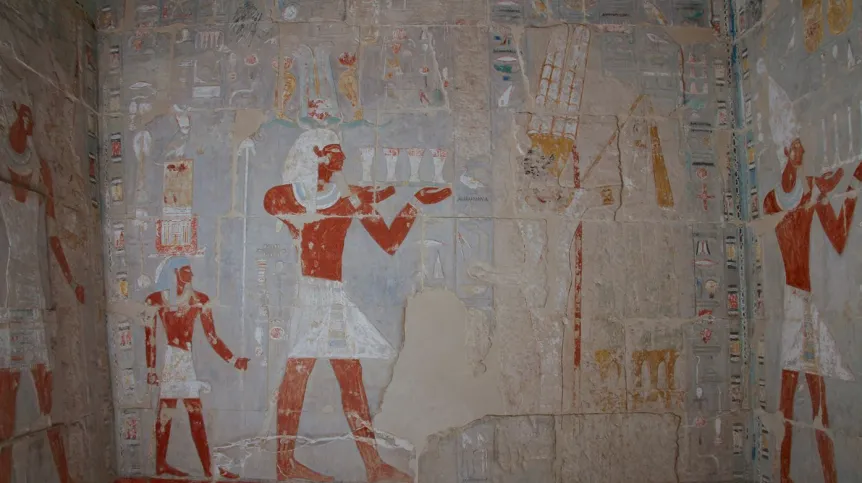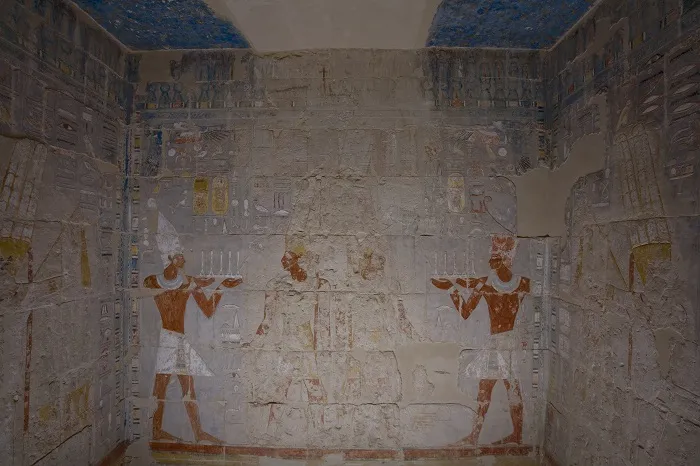
Tourists can now visit more monuments investigated and restored by PCMA UW expedition in Egypt: the Northern and Southern Room of Amun on the Upper Terrace of the Temple of Hatshepsut in Deir el-Bahari and the Tomb of Meru at the necropolis of North Asasif.
The Temple of Hatshepsut in Deir el-Bahari (Western Thebes) served as the burial temple of this queen, who ruled Egypt during the 18th Dynasty (ca. 1473–1458 BCE). The nearby necropolis of North Asasif is the burial place of Egypt's most prominent officials from the Middle Kingdom period (2055–1773 BCE).
"The opening to the public of new rooms in the temple of Hatshepsut and the tomb of an official named Meru in North Asasif is the culmination of many years of work by archaeologists, conservators and architects. It is also the fruit of close cooperation between Polish and Egyptian specialists, who are equally committed to learning about, understanding and preserving the heritage of antiquity. The result of these efforts, in the form of the newly opened rooms and tomb, can from today be admired by tourists from all over the world." – said Dr. Patryk Chudzik, the director of the PCMA UW expedition to the Temple of Hatshepsut.
The opening took place on 9th February in a ceremony that was attended by Dr. Mustafa Waziri, Secretary General of the Supreme Council of Antiquities, Dr Mohamed Abd el-Badeia, General Director of Antiquities in Upper Egypt, Dr. Fathy Yaseen, General Director of Antiquities of Luxor Governorate, Dr. Bahaa Gaber, General Director of Antiquities of the West Bank of Luxor and his Deputy Dr. Ezz el-Din Kamal el-Nuby, with a special appearance by the eminent Egyptian archaeologist, Dr. Zahi Hawass. The PCMA UW was represented by Dr. Anna Wodzińska, director of the PCMA UW Research Centre in Cairo and heads of the PCMA UW expeditions to the Temple of Hatshepsut and North Asasif.
The newly-opened rooms of the Temple of Hatshepsut flank the Main Sanctuary of Amun-Re, which opened to the public in 2017. Their reconstruction is the result of the work of conservators, architects, structural engineers and Egyptologists from the Polish-Egyptian Archaeological and Conservation Expedition.
As indicated by the themes of the restored wall decoration, the Southern Room probably stored aromatic substances and linen robes used during rituals. The walls of the Northern Room, of unknown function, depicted the offering of sacrifices to Amun by Hatshepsut and her ward, Thutmose III, and some ritual acts they performed. When Thutmose III ascended the throne on his own after a period of co-regency, Hatshepsut was removed from the decorations throughout the temple.

In both rooms, in the least prominent place behind the doors, a figure of Senenmut, Hatshepsut’s most important courtier was depicted along with an inscription explaining that the queen allowed his name to be engraved in all the rooms of her temple. But only in these two was he shown standing rather than kneeling, which may suggest a special function of these rooms.
The Tomb of Meru was carved into a rocky slope called the North Asasif, which is a continuation of the rock amphitheater of Deir el-Bahari. Meru was a high-ranking official at the court of Mentuhotep II Nebheperta (2055–2004 BCE) a ruler of the 11th Dynasty and founder of the Middle Kingdom, tomb and mortuary temple are located in Deir el-Bahari. – "The Tomb of Meru is the first monument from such an early period in Western Thebes to be made accessible to visitors," – points out the head of the PCMA UW expedition in North Asasif, Dr. Anastasiia Stupko-Lubczynska.
The Tomb of Meru faces the procession avenue leading to the temple of Mentuhotep II. It consists of a facade, a corridor leading to an offering chapel, with a niche for a statue of the deceased. Before reaching the chapel, a corridor opens in the floor, descending to a burial chamber with a "sarcophagus" – in this case, a rectangular cavity carved into the rock floor. This is the only decorated room of the tomb, with an unusual decoration executed in painting on a base of lime plaster. – "What we have here is a unique combination of two traditions of decorating burial spaces: a royal one, used in Old Kingdom inscribed pyramids, and a non-royal one, and both traditions seem to have reached Thebes from distant Memphis (modern Cairo)," – Dr. Stupko-Lubczynska explains.
The Tomb of Meru had been known since at least the mid-19th century; in 1996, some wall paintings were cleaned by Italian conservators. Between 2015 and 2023, archaeologists from the PCMA UW Asasif Project in cooperation with the Ministry of Tourism and Antiquities of Egypt, worked with conservators from the Academy of Fine Arts in Warsaw on conservation and documentation of the tomb.

The Polish-Egyptian Archaeological and Conservation Expedition at the Temple of Hatshepsut in Deir el-Bahari has been operating since 1961. It was established by Prof. Kazimierz Michałowski, the doyen of Polish Mediterranean archaeology. For more than 60 years, archaeologists, conservators and architects have been working on the documentation and reconstruction of the temple’s remains.
kap/
Gallery (6 images)
-
 1/6Photo: A.Stupko-Lubczynska - UW
1/6Photo: A.Stupko-Lubczynska - UW -
 2/6Photo: M.Jawornicki-CAS UW
2/6Photo: M.Jawornicki-CAS UW -
 3/6Photo: D.Wieczorek-CAS UW
3/6Photo: D.Wieczorek-CAS UW -
 4/6Photo: M.Jawornicki-CAS UW
4/6Photo: M.Jawornicki-CAS UW -
 5/6Photo: M.Jawornicki-CAS UW
5/6Photo: M.Jawornicki-CAS UW -
 6/6Photo: M.Jawornicki-CAS UW
6/6Photo: M.Jawornicki-CAS UW













